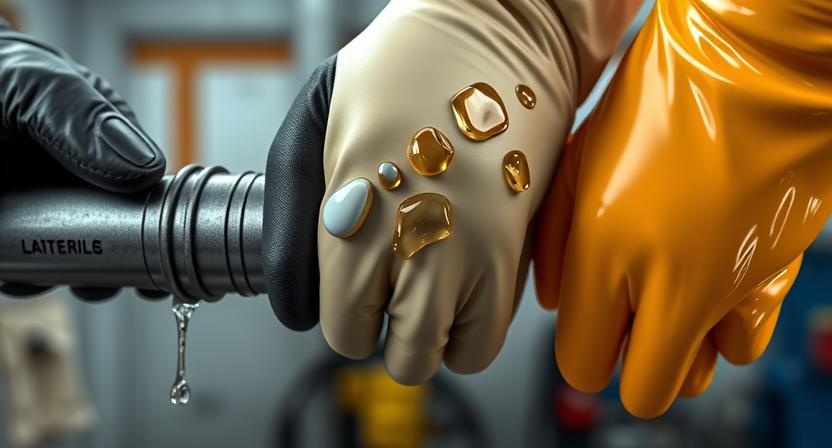Best Dipped Gloves for Oil and Chemical Resistance

Introduction
Workers in manufacturing, automotive, and chemical industries face daily exposure to oils, solvents, and harsh substances. Choosing the best dipped gloves for oil and chemical resistance is critical for safety, productivity, and compliance. But with so many options—latex, nitrile, PVC—how do you pick the right one?
This guide compares the top dipped gloves for oil and chemical protection, helping business owners, safety suppliers, and purchase managers make an informed decision.
1. Why Oil & Chemical-Resistant Gloves Matter
Workers handling oils, fuels, acids, or solvents need gloves that:
✅ Resist degradation – Don’t break down upon contact
✅ Prevent permeation – Stop chemicals from soaking through
✅ Ensure grip – Reduce slips in oily conditions
✅ Meet safety standards – OSHA, ANSI, or EN compliance
Did You Know?
Chemical burns account for ~13% of workplace hand injuries (Source: OSHA)
Nitrile gloves offer 3x better chemical resistance than latex (Source: CDC)
2. Top 3 Dipped Gloves for Oil & Chemical Resistance
1. Nitrile Dipped Gloves – Best Overall Protection
✔ Superior chemical resistance – Blocks oils, acids, and solvents
✔ Puncture-resistant – 2x more durable than latex
✔ Hypoallergenic – Safe for workers with latex allergies
Best for: Automotive, chemical plants, pharmaceuticals
2. Latex Dipped Gloves – Good for Mild Chemicals
✔ Flexible & comfortable – Ideal for precision tasks
✔ Biodegradable – More eco-friendly than synthetics
⚠ Limitations: Avoid for harsh chemicals (e.g., acetone, gasoline)
Best for: Food processing, light industrial work
3. PVC Dipped Gloves – Budget Option for Oils
✔ Affordable – Cost-effective for bulk use
✔ Water-resistant – Good for wet environments
⚠ Avoid: Strong acids or solvents (can degrade PVC)
Best for: Cleaning, light machinery maintenance
3. Key Features to Compare
| Feature | Nitrile Gloves | Latex Gloves | PVC Gloves |
|---|---|---|---|
| Oil Resistance | ⭐⭐⭐⭐⭐ | ⭐⭐⭐ | ⭐⭐ |
| Chemical Resistance | ⭐⭐⭐⭐⭐ | ⭐⭐ | ⭐⭐⭐ |
| Durability | ⭐⭐⭐⭐⭐ | ⭐⭐⭐ | ⭐⭐⭐ |
| Comfort | ⭐⭐⭐⭐ | ⭐⭐⭐⭐⭐ | ⭐⭐ |
4. How to Choose the Right Gloves
For Heavy Chemical Exposure (e.g., Acids, Solvents)
➡ Pick Nitrile – Resists benzene, methanol, and sulfuric acid
For Oil & Grease (e.g., Automotive, Machinery)
➡ Nitrile or Thick PVC – Nitrile offers better grip
For Mild Chemicals & Food Safety
➡ Latex (if no allergies) or Nitrile
For Budget-Conscious Buyers
➡ PVC Gloves – Decent for water and light oils
5. Industry-Specific Recommendations
🏭 Automotive & Manufacturing
Ansell HyFlex® 11-800 (Nitrile-coated, cut-resistant)
🧪 Chemical Processing
SHOWA 720 (Heavy-duty nitrile, chemical-proof)
🍽️ Food Handling
SAS Safety 6650 (Latex-free, FDA-approved)
Final Verdict & CTA
For heavy chemical/oil resistance, nitrile gloves are the #1 choice. Latex works for mild chemicals, while PVC suits budget buyers.
Need bulk orders of chemical-resistant gloves?
📞 Contact Us for wholesale pricing and expert recommendations!
FAQs: People Also Ask
Which gloves resist gasoline best?
Nitrile gloves latex and PVC degrade faster.
Are there eco-friendly chemical-resistant gloves?
Latex is biodegradable, but nitrile offers better protection.
How long do nitrile gloves last against chemicals?
Varies by thickness—8–12 mil gloves last longer (check manufacturer specs).
Can PVC gloves handle motor oil?
Short-term use only; nitrile is better for prolonged exposure.
